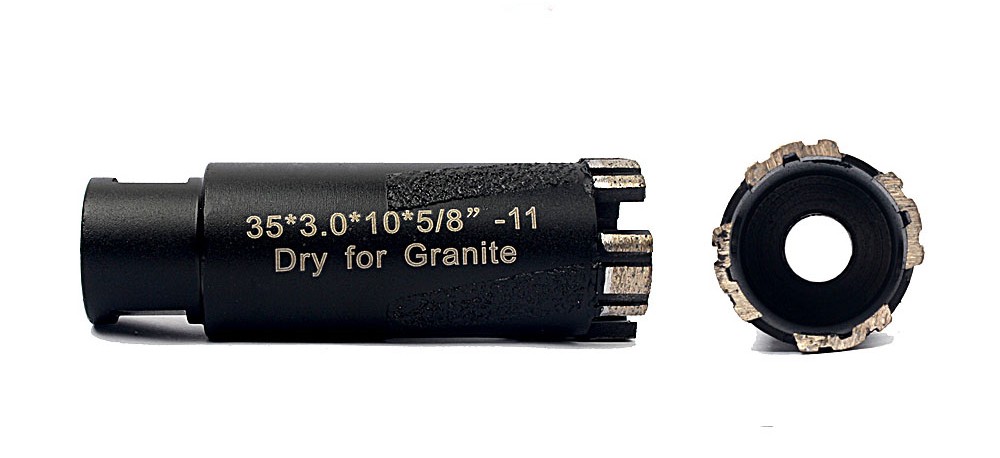Cutting mechanism and characteristics of diamond bit

Cutting Mechanism of Diamond Bits
The synthetic diamond polycrystalline layer and the cemented carbide substrate are synthesized under high temperatures and high pressure to form a diamond drill bit. To better understand the cutting mechanisms behind these remarkable tools, let's dig into the following: The main function of the diamond bit is realized by the action of diamond particles.
In hard formations, diamonds exert considerable pressure on the rock under WOB, pushing it into a state of high stress, causing the lithology to change from brittle to plastic. The depth of the diamond cut is closely related to the penetration depth of diamond particles, similar to the plowing process. This phenomenon is aptly called the plowing action of the diamond bit. However, when dealing with brittle rocks such as sandstone or limestone, the cutting mechanism is different. In these cases, even under the influence of drilling torque, the volume of diamond grains on the drill bit exceeds its volume of penetration and rotation. Therefore, when the applied pressure is not too high, small grooves are formed along the direction of the diamond movement. Under higher pressures, these small grooves rupture not only at the surface but also deep in the rock, exceeding the cross-sectional size of the diamond grains.
The effectiveness of diamond bits in breaking rock is not only affected by lithology but also by various external factors such as pressure and temperature. Similar to roller cone bits, rock fragmentation occurs in three ways: surface fragmentation, fatigue fragmentation, and volume fragmentation. In order for diamond particles to successfully penetrate the formation rock and achieve the ideal rock-breaking effect, sufficient specific pressure must be applied to penetrate the rock volume.
These new insights reveal the complex cutting mechanisms behind diamond bits, emphasizing the critical role played by pressure and lithology in achieving optimal drilling results. By understanding these mechanisms, drill bit manufacturers and industry professionals can optimize their drilling strategies, improving efficiency and overall drilling performance. As the technology continues to improve, researchers and engineers may discover more subtle details about the cutting mechanism of diamond bits. These discoveries will further refine the design and application of these important drilling tools, revolutionizing industries as diverse as oil and gas exploration, mineral extraction, and geotechnical engineering.
Features of diamond drill bits
Tip teeth: The cutting teeth of the diamond bit are made of super hard diamond composite material, which makes it stand out from other products in its class. This material has exceptional abrasion resistance and impact toughness, ensuring unmatched durability and longevity. With these sharp teeth, diamond drill bits can withstand the harshest drilling conditions, ensuring long hours of productive drilling.
Drilling in Hard Rock: One of the most impressive properties of diamond bits is their ability to drill holes in hard rock with little effort. This is due to the exceptional strength and hardness of diamond composites. Diamond bits penetrate these challenging formations with ease, unlike conventional drill bits, which may have difficulty penetrating these formations. This capability provides operators with the flexibility and efficiency needed to tackle demanding drilling projects without compromising the quality or accuracy of the drilled holes.
High Drilling Efficiency: Efficiency is a key factor in any drilling operation, and diamond bits excel in this regard. The combination of super hard diamond composite teeth and the optimized design of the drill bit achieves high drilling efficiency. By minimizing drag and maximizing the force exerted on the rock formation, diamond bits can quickly and smoothly complete drilling tasks, saving valuable time and resources.
Protected Drill Diameter: Another noteworthy feature of diamond drills is their ability to maintain the integrity of the drill diameter. Conventional drill bits are constantly subject to wear, resulting in a reduction in drill diameter over time. However, the wear resistance of the diamond composite material used in the diamond drill bit keeps the diameter intact, which guarantees the precision and accuracy of the drilling throughout the drilling process. This feature allows the operator to consistently achieve desired results without frequent drill bit changes.
-
Online service
-
Official wechat account

-
QQ:40933769
-
E-mail:sales@z-lion.com
Online Message
Please feel free to give your inquiry in the form below. We will reply you in 24 hours.

